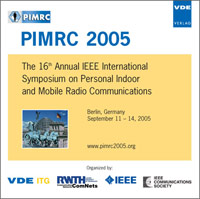Physical Layer Design Issues Unique to Cognitive Radio Systems
Conference: PIMRC 2005 - 16th Annual IEEE International Symposium on Personal Indoor and Mobile Radio Communications
09/11/2005 - 09/14/2005 at Berlin, Germany
Proceedings: PIMRC 2005
Pages: 5Language: englishTyp: PDF
Personal VDE Members are entitled to a 10% discount on this title
Authors:
?abri?, Danijela; Brodersen, Robert W. (Berkeley Wireless Research Center, University of California at Berkeley, USA)
Abstract:
Cognitive radio systems offer the opportunity to improve spectrum utilization by detecting unoccupied spectrum bands and adapting the transmission to those bands while avoiding the interference to primary users. This novel approach to spectrum access introduces unique functions at the physical layer: reliable detection of primary users and adaptive transmission over a wide bandwidth. In this paper, we address design issues involved in an implementation of these functions that could limit their performance or even make them infeasible. The critical design problem at the receiver is to achieve stringent requirements on radio sensitivity and perform signal processing to detect weak signals received by a wideband RF front-end with limited dynamic range. At the transmitter, wideband modulation schemes require adaptation to different frequency bands and power levels without creating interference to active primary users. We introduce algorithms and techniques whose implementation could meet these challenging requirements.


